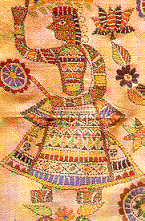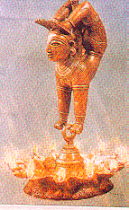INDIAN CRAFTS
Crafts are an integral part in the life of an Indian, despite the rapid social and technological changes that are taking place. In the Western world, special artists create craft objects and they are considered as luxury items. But in India like many other developing countries it is the main source of employment for a vast majority of the population, next to agriculture.
Handicrafts can be defined simply as objects made by the skill of the hand and which carry a part of the creator as well as centuries of evolutionary tradition. It can range from the simple clay- lamps to the diamond -studded jewellery items. Handicrafts consists of objects created by skilled people for religious rituals, like wedding and celebrations and for personal use as well as luxurious ones created by specialized craftsmen for specific requirements. Handicrafts bring a great sense of grace to every home be it the poor hut or the opulent star hotel. There is a timeless quality in these craft objects, for they have evolved over centuries and continue to be made even today with the same sentiment.
There are three main classifications of crafts .
- Folk crafts
- Religious crafts
- Commercial crafts.

Bihar Folk Embroidery

Bronze lamp used for worship
Specialized craftsmen of a particular group who are specialized in a particular skill and who can completely master the craft do commercial crafts. They even have sub groups, which work for particular groups, and their tools and techniques may vary. The Weavers, the Dyers, the Printers, the Goldsmiths and the Carpenters are some of the commercial craftsmen.
History of crafts in India
Crafts were an important commodity for world trade and they were a part of the economy in India, since ancient times. Trade links between India and the rest of the world existed from ancient periods. India being the home of cotton had textile trade with the Far East and the Western world. Indian textiles and their permanent dyes were accepted throughout the world. Roman trade documents mention that silk was exported from India to Europe from the 6th century A.D. The Arab sailors brought silver and gold from their countries and took back shiploads of handicraft objects from India to the Far- East. In the North, caravans carried woven textiles along the Silk route and went right unto Moscow by the Fur- route.Under the good patronage of the early Mughals, India's handicrafts reached its pinnacle of perfection. Crafts like carpets, textiles and jewellery were developed into fine arts. The famed Mughal Emperors namely Akbar, Shah Jahan and Jehangir invited skilled craftsmen from all over the world and blend their native ideas with our own techniques and skills. Brocading and velvet manufacturing developed rapidly in India than in their native countries. But with the break- up of the Mughal Empire and the growing enmity between the smaller Princely states, local crafts lost their centuries- old local patronage. With the East India Company coming to India, the volume of trade reduced though they managed to strive.
England flooded the Indian market with its cheap machine-made items, which ousted the homemade crafts. A number of craftsmen were turned destitutes overnight. Those who continued with their craft had to compete with the machine-made goods, that quality was made to suffer. Gandhiji's Swadeshi movement focused on the plight of the Indian craftsmen and on the need for maintaining the ancient craft traditions.
After Independence, The Handicrafts Board was set up to look into the plight of the dying crafts. Slowly demand grew for these items both at home and also abroad. Recent export figures show that India is lagging behind in many handicraft commodities except in the case of gems and jewellery items.
Despite the growth of handicrafts industry in India, the average earnings of the craftsmen when compared to other fields is very low. Hence the younger generation is moving onto other fields with only the elder craftsmen left over. The average age of many master craftsmen is around 50 years.
Improving educational system and lifestyles of the middle class people contribute a lot for the eroding of the native crafts in India. Cheap plastic items have now flooded the market and people have left out the age-old clay and metal containers. They do not understand the harmfulness of plastic items, which may react with their food . Also they have moved onto wearing synthetic clothes avoiding good, comfortable and cheap cotton woven items, just for their patterns and cost.
The need of the hour is assistance for the craftsmen to improve their techniques, availability of good raw materials, direct marketing channels, credit and enough wages and socio-economic benefits


